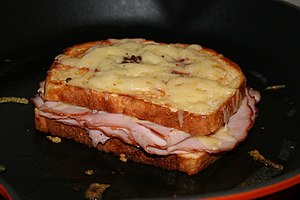Hmmm.... croque monsieurIn French the word for friend is copain, which comes from the Latin cum pane (with bread) and is the person with whom you share your bread.
One could be forgiven for thinking that the French invented bread, but it was probably the Egyptians: however, while few people have heard of eesh baladi, nearly everyone knows what a French stick is.
Along with strings of onions and smelly cigarettes, the baguette – that thin loaf of crusty bread that makes a sandwich as long as your arm – is an enduring, albeit hackneyed, symbol of France.The elongated form of the baguette was created in the early 20th century and was invented for townspeople who lived near a bakery and could buy their bread fresh, twice a day. The bread was made to be eaten on the same day as purchase and this is still the case.
I have tried wrapping leftover baguette in a tea towel; I have put it in a plastic bag overnight; I have popped dry bread in the microwave; I've sprinkled it with water and baked it in a hot oven, but the result is always the same – day-old French bread tastes like carpet slippers.
Bread has been the staple diet of the French for centuries, even if they are now eating a mere five ounces a day as opposed to the two pounds they were eating in 1900. The Ancient Gauls ate their food off a thick slice of bread called a tranchoir and when told to "finish your plate", that's exactly what they did. This custom lasted well into the 14th century, although the wealthier classes would give the sauce-sodden tranchoir to the poor to finish off.
The quality of bread eaten was an indicator of wealth and the whiter and finer the flour, the more expensive the bread. At this time, the humble peasant had to make do with coarse, black rye bread that he made himself – but not before he'd paid tax to his overlord to grind his flour in the communal mill and more tax to be allowed to use the communal oven.
As if that wasn't humiliating enough, he often had to add straw or even clay to the grain when times were hard, producing a loaf that, I suspect, closely resembled the "100 per cent natural high-fibre rustic bread" you can buy for a small fortune in any organic bakery today.
The rising price of bread was one of the reasons for the French Revolution. The harvest in 1788 had been extremely poor and the population was starving. At the beginning of 1789, riots broke out throughout the country, and not for the first time.
People were demanding work and bread and it was then that Marie-Antoinette – a little half-baked herself – was supposed to have suggested that if there was no bread, they could eat cake instead (actually, she didn't say that, but I wanted to get that joke in about her being half-baked...) Later, in 1791, the Constituent Assembly fixed the price of bread and decreed that bakers could only bake one sort of loaf, the "Equality Loaf", made from three parts wheat flour to one part rye.
In the 19th century, the mechanical kneading machine was invented and bakers no longer had to knead their dough by hand – or with their feet, which had been the case for some types of bread. Consumers were hostile to the idea but professional bakers welcomed the chance to lighten their workload.
Further changes followed, including the replacement of brewer's yeast with baker's yeast and the use of steam ovens over wood-fired ones until finally, in the 1950s, bread was being made in what is known as industrial bakeries, thus becoming plentiful and cheap. In the face of this competition, 6,786 traditional bakeries were forced to close down between 1968 and 1975.
Today, shops known as "baking terminals" sell bread that they have bought frozen and partially baked and which they have finished cooking in their own ovens, to con you into thinking it is homemade. American and British-type sliced bread has also become popular – I have even seen it sold without crusts: pale and limp and wrapped in cellophane. It's enough to put you off your croque monsieur...
Thankfully, there are many for whom bread is still the staff of life and 36,000 traditional boulangeries continue to flourish in France (that's one for every 1,500 inhabitants). Each region produces its speciality in a myriad of shapes and sizes, some flavoured with walnuts, raisins, bacon, olives, basil or garlic and others with names that read like poetry: fougasses, flûtes and fibassiers, polka, choine and gâche.
In Grenoble, where I live, the owner of the upper-crust bakery, the Talemelerie (from the old French word for "baker"), has invented forty types of bread himself, including the Méridional, with aniseed and raisins, and a loaf made with cranberries.
The feast day of the patron saint of bread, Saint Honoré, is celebrated on May 16 and events that include processions, free breakfasts and bread tasting are held throughout the country. And once a year, the Grand Prix of the Parisian Baguette (yes, really), is organised by the City of Paris, the victor walking away with a prize of €4,000 and the honour of providing the president with his daily bread for a year.
Now, that's what I'd call a real breadwinner!

1 comment:
Thanks for the mention, Daniel :-)
Damn it - I'll read your blog!!
Gill
Post a Comment